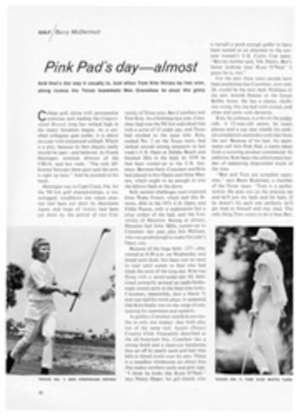
BABES WHO ARE GOING GUNNING
America held the first of its quadrennial political conventions high in the Colorado Rockies last week and for soaring exuberance, bitter disappointment, grandiose groaning, foppish lobbying and closed-door pressuring, the Democrats and Republicans will be hard pressed to match the exhausting Olympic Trials that dragged on for two weeks at the Air Force Academy. Yet maybe it was worth it. What Coach Henry Iba and the selection committee finally came up with to represent the United States at Munich turned out to be the ultimate in new-look tickets—a fresh, unfledged and callow group of children; the youngest team to go forth into battle since Lord of the Flies.
"I got me a bunch of babies here," Iba said one evening after observing an endless stream of faces, names, numbers and colored uniforms running around below him. "But there's a lot of talent, too. We'll just have to get some leaders and some brutes who won't get pushed around."
The youthful flavor of this year's team is by design, not happenstance. The United States has never lost an Olympic basketball game, much less a gold medal in the sport, but four years ago at Mexico City several international teams appeared to have caught up with the Americans (notably Russia, Yugoslavia and Brazil) and U.S. officials quickly realized that the Red, White and Blue could no longer field one of its usual pickup teams and expect the rest of the world to lie down and play green. One result was Olympic development camps where high school seniors and college freshmen, among others, could begin early to compete under international rules, which put a premium on nonstop action, physical strength and rough banging. Another was a new sense of determination. By the time Iba and Coaches Don Haskins and John Bach gathered in Colorado Springs, they knew what they were after.
In contrast to the relaxed 1968 Olympic Trials at Albuquerque, the atmosphere last week was stern and cloistered. Everyone was confined to the Academy grounds ("This awful prison base," Ohio State's Allan Hornyak called it). They lived in cadet quarters, had seven a.m. wake-up, 11:30 p.m. lights-out and the use of hardly any telephones or television.
"I'm hating this whole thing," said Ed Ratleff of Long Beach, who was to make the team. "Everything is a mile away. All we do is walk up and down steps. Where is the air?"
"I haven't seen a shaved leg in 12 days," said Doug Collins of Illinois State, who made it also. And another brand-new Olympian of ol' countrified tastes and manner spoke for the multitude. "When this is over, me and my partners are taking a van to the hills, opening up some Coors and turning on the stereo. And I ain't never, ever comin' back to this here Air Force Academy military fightin' place."
The format of the trials also had been vastly overhauled since the confusing "alphabet war" of four years ago when the NCAA, AAU, NAIA, Armed Forces, NJCAA and everyone but NASA fielded some kind of squad. In Colorado there were eight teams composed in Mixmaster fashion of college kids, AAU veterans and military personnel, all of whom played each other—for a total of 28 games in seven days. While this system rendered spectators deaf, dumb and stumbling blind, it also evened up the competition, merged identities and made for fewer arguments, political power plays and hurt feelings in the selection meetings. When the trials were over the U.S. seemed to have a balanced, young and exciting squad. Here it is.
Centers: Swen Nater, UCLA; Dwight Jones, Houston; Tom Burleson, North Carolina State.
The best amateur center in the world, the feared and acclaimed Bill Walton, stayed away because of bad knees, but the selection committee picked Walton's teammate and proxy, Nater.
This is no fluke. The 6'11", 253-pound native of Holland has been playing the game for only three years but he bounded out from the shadows of the UCLA bench last week with a fury, and he is ready to shine. He started shooting the moment he hit camp and did not stop until he had led all scorers. "He knows once he gets back to Bruin land there will be no more free shots," said one pro scout.
Jones, who performed below expectations in the Pan-Am Games last summer and then had a disappointing sophomore winter at Houston, is bent on redemption and, at times last week, he played up to his considerable potential. In one game, however, Big D got in a scuffle, was taken out and sulked on the bench for 16 minutes (the committee counted). "You can't lose your temper more than once," said Iba. "All Jones has to do is concentrate to really help us." All Burleson has to do is stand around. He is 7'4", and happily does a lot more than stand.
Forwards: Bobby Jones, North Carolina; Mike Bantom, St. Joseph's; John Brown, Missouri; Jim Brewer, Minnesota.
The second Jones boy to make the team is undoubtedly the biggest surprise of all the selections. To get to the final 12 he had to beat out a slew of excellent cornermen, including the top rebounder in camp, Marvin Barnes, and everybody's front-runner, Tom McMillen. The latter's absence from the team is a shock and it is still unclear why he was honored only as an alternate, but Jones is an exquisite player in his own right. Sure-handed and quick-witted, he moves without the ball better than any young forward today.
Bantom and Brown, the "driving forwards" Iba likes to talk about as well as win Olympics with, both possess fine all-round games as well as the classic facial features of movie stars. They will look terrific in those Olympic suits.
From the beginning Minnesota's Brewer took a spot for himself as the most impressive of the big men. "This guy would just as soon hair-lip you as let you score," said Haskins. A defensive specialist, Brewer blossomed into a scoring threat last week, but his value will be as an intimidating center.
One of the most popular men in camp, Brewer was tested early when he was placed on the same team with Ohio State's Luke Witte, who was beaten up by Brewer's Minnesota teammates last season. "I have to live with that night for the rest of my life," said Brewer. "But men must get along. Luke and I respect each other; nothing has come up." For his part, Witte seemed completely recovered from the ambush; he played well and earned an alternate's berth.
Guards: Ed Ratleff, Long Beach; Kevin Joyce, South Carolina; Ken Davis, Marathon Oil; Tom Henderson, Hawaii; Doug Collins, Illinois State.
If there is a weak spot on the team, it may be at guard, even though in Ratleff, Joyce and Collins the U.S. has three men who can tear open any game. The backcourt lacks what Bach calls the "athletic viciousness" that was supplied by poker-faced Jo Jo White and tattooed Mike Barrett on the 1968 team.
The 6'6" Ratleff, who can also swing to forward in Munich, did not have a good camp but it is common knowledge he does not like to practice and is only at his best in tough contests. Ratleff's game is almost too smooth, and his casual manner and phlegmatic look sometimes make it appear he is not trying. But, as Iba said, "that man will get us the basket when we need it."
Joyce, a good shooter and intense scrapper who leaves his heart on the floor even in the briefest of scrimmages, may develop into the strong defensive guard the U.S. coaches are looking for, although his leadership credentials are suspect. For that role the team looks to Davis and Henderson. The former, a veteran of international competition, is a smart little operator whose experience and playmaking contributions should be a steadying factor on such a young team. Henderson, though just out of San Jacinto Junior College, made his mark on defensive ability and willingness to sacrifice. He is 6'2", strong and powerfully built. The coaches think he can be the catalyst and floor leader.
Which leaves Collins, a 6'6" blithe spirit of remarkable shooting range who was the hit of the training camp. That rarest of specimens—a white star playing for a black coach (Will Robinson)—Collins has been at obscure Illinois State for three years. Last season he was the third leading scorer in the country. He has floppy hair, bunny rabbit teeth, superb quickness off the dribble and a cocksure attitude that permeates his every move. After he had scored 30 points (high for the trials) he was spied by Bach shuffling along sucking an icecream stick. "Hey, Collins," said Bach, "you play defense just like that—icecream defense. You're going to be in for the shock of your life when Mr. Iba gets hold of you."
"No I won't," said Collins.
Later, he explained. "That's bull about my defense. It's just hard, being me. How many times have you seen a guy averaging 33 play good defense? I just have to adapt. Iba will see. So will the Russians and all them others. We'll win it all. Talent always prevails."
Out of the mouths of babes...a gold medal?
PHOTO
Doug Collins, unheralded high scorer from Illinois State, shot his way onto the team.

